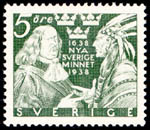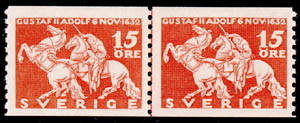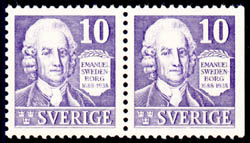| Perplexing Swedish Perforations: Sweden Perforation Types & Formats |
|

by Jay Smith & Associates
Acknowledgments
The stamps of Sweden, and their various perforation formats, represent -- all at the same time -- both innovation and frustration for philatelists.
Sweden was an early experimenter with both coil (1903) and booklet (1904) stamps, utilizing the copper-plate engraved 5 and 10 öre Oscar stamps. Needless to say, examples of these early coil and booklet issues are quite scarce today.
Since the 1940s, Sweden has been known for issuing virtually all of its stamps either in coil or booklet form, or in souvenir sheets containing only one set of stamps. The number of "ordinary" sheet stamp issues can be counted on one hand. The coil and booklet stamps virtually all have one or more imperforate side, though some of the modern booklets do contain perforated 4-side stamps in the form of a small souvenir sheet with selvedge all around. Collecting modern Swedish stamps requires understanding the terminology surrounding these formats.
Collecting Styles:
Swedish (and other Scandinavian stamps, to the extent that there are differing perforation formats) are typically collected in one of two styles by collectors who choose to use a pre-printed album.
The style used in the Scandinavian and European countries is universally one that includes pairs and panes of booklet stamps; presented so that the pairs are symmetrical in appearance and all the different straight edge sides are represented. This is often called "European format". In 1973 I coined the abbreviation "prt" (for "pairs remain together") as a handy way to identify sets of this format.
The style presented by American-made albums is typically that of showing only SINGLES of each stamp. The American albums do include both the coil and booklet stamps, but only one of each. The American-made albums typically do not show both sides of the booklet pair, but may sometimes include the complete pane (instead of showing the singles from the pane) if all the stamps in the pane are different. Sets in this "singles" format are often termed "American format" or "regular format" (though the "prt" format is really probably the more "regular" of the formats).
Fortunately, philately is all about enjoyment and doing your own thing. If you make your own album pages or use a stock book to hold your collection, you can do whatever pleases you.
Terminology:
The philatelic world has largely adopted Sweden's own letter- identification system for Swedish (and other Scandinavian) coil and booklet stamps.
|
|
Single Stamps: |
 |
|
A = Straight edges on two OPPOSITE sides (and thus perforated on two OPPOSITE sides). This is the standard coil stamp, but also applies to some one-stamp-wide booklet format issues. |
 |
|
B = Straight edge on ONE side (and thus perforated on three sides). This is the standard single stamp from a booklet. |
 |
|
C = Perforated on all four sides. This is the standard sheet stamp. |
 |
|
D = Straight edges on two ADJACENT sides (and thus perforated on two ADJACENT sides). This is also called a "corner cut" stamp and originated with the slot-machine booklet stamps of the late 1950s and the 1960s. They are also found on modern issues that have been produced with straight edges around three sides of the booklet pane. |
|
|
Pairs: |
 |
|
BB = Pair of booklet stamps with straight edges on opposite sides; symmetrical appearance. This is the typical "Swedish booklet pair" called for by most European-made albums and is the standard method of collecting in Scandinavia. |

 |
|
BC or CB = Pair of stamps with the straight edge on only ONE side of the pair; a combination of the B and C format. This is discussed in greater detail below. |

 |
|
DD = Pair of corner-cut stamps in which BOTH stamps are corner cut. The Scandinavian catalogs may use the term DD1 and DD2 (I use the terms "DD-top" and "DD-bottom") to indicate whether the cutting is at the top or bottom of the pair - both may exist for some issues. |

 |
|
SX = Pair of stamps with TWO DIFFERENT DESIGNS. These come from three sources: a) slot-machine booklets; b) many modern booklets combinations of commemorative stamps; and c) modern coil issues that consist of two alternating stamp designs. The Scandinavian catalogs may use the terms SX1 and SX2 to indicate if the pairs show the stamps in one-two OR two-one order. |
Coil Stamps:
Sweden's very first coil issues were made by gluing together fully perforated sheets of stamps and cutting them into rolls -- there was no attempt to slice nice neat edges between the rolls. It was not until 1920 that Sweden started to issue coil stamps that looked like coil stamps; with only two sides perforated. This was the start of the "bandmärken" (roll or coil stamps) era of Swedish philately.
 
A great surprise to many American collectors is that in 1920, the Swedish post office started using an American Stickney stamp printing press... and thus began the era of LINE PAIRS on Swedish stamp issues, lasting until the end of 1936. The final run of the Stickney press was for the 35 öre King left profile stamps. The press used two half cylinders; the plate (cylinder) join lines thus appeared twice for every full cylinder rotation. All the stamps of the era were printed on this press, thus line pairs can be found on both the coil and sheet stamps (even the sheet stamps used to make booklets) of every stamp issue, with one exception. The 1924 World Postal Congress and UPU issues were printed using only half-cylinders each, thus the stamps of both issues were printed with every full revolution of the printing cylinder. I believe the only surviving combination pairs (with plate join line between) are in the Swedish Postal Museum. Line pairs of the coil stamps are fun to collect and a considerable challenge to find. Line pairs of the perforated 4-side stamps are extremely difficult to find! To my knowledge, there has never been a catalog or price list issued for these line pairs. They are NOT widely collected in Sweden and apparently early collectors considered the line to be "disfiguring". Mint examples were consumed for postage and used examples were often simply discarded. I do stock Swedish line pairs and am happy to assist with approvals.
From 1920 to today, the coil stamp has been Sweden's principal production format. Coils provide ease of dispensing for the postal workers and supposedly ease of use for the patrons.
In earlier days, the preferred collecting style in Sweden was to collect the coils in 5-strips. Having seen such collections, I can say that the visual effect is dramatic! However, as the cost of postage increased, and printed albums became more prevalent the 5-strips fell out of favor.
The American style of collecting American coil stamps has a long tradition of collecting in pairs and/or line pairs. (It is interesting to note that with the advent of American coil plate numbers, those are now often collected in 5-strips!) However, when it comes to (anybody) collecting Swedish coil stamps, there has never been much interest in collecting them in pairs. Most collectors collect (and all printed albums show) them as single stamps.
   
There is another collectible aspect of Swedish coil stamps: back numbers. Starting on 16 September 1920, numbers have been printed on the backside (on top of the gum) of Swedish stamps. Prior to the 1970s, the numbers were printed on the rolls of 500 stamps (not the rolls of 100 stamps), presumably for use by postal clerks. A number was printed on the back of every 20th stamp; "2" on the 20th stamp, "4" on the 40th, etc. Examples of these early back-numbered stamps are very scarce. I have seen examples in either red or black from the 1920s to the 1950s, and only black since then, in various type styles. Starting in the 1970s, however, the numbers appear every 10 stamps and are specifically for inventory counting use by postal clerks. Though German coil stamps with back numbers (every 5 or 10[?] stamps) are avidly collected, this style has not (yet?) caught on for Swedish stamps.
 
Booklet Stamps -- BC & CB Pairs:
The first booklets produced by Sweden contained stamps perforated on all four sides. Those first Oscar issues were printed in special 90-stamp sheets, however, a single stamp from a booklet was not distinguishable from an ordinary sheet stamp. The perforated 4-side booklets continued through the Gustav issues, and the Bandmärken era of the 1920s-30s. It was in 1938 when a new generation of printing and production equipment was purchased that Sweden's booklet stamps started to change. With the new Goebel printing press, not only did the quality of engraving, printing, paper, perforating, and centering improve dramatically, the booklet stamps started to have one or more imperforate sides.
Starting with the Swedenborg commemorative issue of 29 January 1938 and phased out by the end of 1941, Sweden's booklets were still hand-produced by tearing up sheets of stamps. However, the sheets were printed on a roll-fed printing press in a continuous web. While viewing the stamps upright, the sides of the web (and its selvedge) were at the top and bottom of the web-roll of stamps. Small-size stamps were printed 10-high, while some larger stamps such as the 1938 "New Sweden" issue were only printed 9-high.
In this era, there were NO perforations between the intended sheets of stamps. To create a sheet of stamps, the continuous web was cut vertically between every 10 stamps (where there were no vertical perforations), thus making a 10-high (or 9-high) by 10-wide sheet. It is this vertical cut (straight edge), on the left and right side of the sheet, that has made some of the stamps of this period so interesting and valuable. These sheet-edge positions are the source of the sought- after BC and CB pairs, with a straight edge only either on the left or right side of the pair. Booklets were made by tearing the 10-stamp-wide sheets into five panes.
The sheets of this era were sold through post offices, as well as being made into booklets. With the ready availability of coil stamps, however, these ungainly sheets were of little interest to the postal public. Extremely few examples of large blocks from these sheets have survived. Any unit wider than two stamps must have come from such full sheets -- and thus represent a different form of issuance; they have come from sheets rather than booklets. (No catalog, of which I am aware, recognizes this fact.)
The story of the popularity of BC and CB pairs, and their inclusion in all European-made albums may or may not be true, but it is worth telling. The E.W. Larsson stamp shop, in Stockholm, was one of the larger Swedish suppliers of new issue stamps in 1938. Mrs. Larsson was in charge of preparing the stamps for sale to the customers and she quickly discovered that she was ending up with a lot of "scrap" postage because the left and right side of every sheet of stamps had a straight edge (which was something completely new to Swedish collectors). It just so happened that the E.W. Larsson firm was also a major producer of Swedish stamp albums -- and Mrs. Larsson saw an opportunity... Rather than just showing a perforated 4-side single stamp in the album supplement pages (in addition to the coil values), she included two pairs of the stamps showing the straight edges: the BC and CB pairs.
Not only did Mrs. Larsson sell more stamps that way (I am a stamp dealer myself, what can I say!), but she started a trend of collecting pairs that continued in similar fashion when automated booklet production resulted in booklet pairs with straight edges on both the left and right of each pair.
In 1940, the Swedish post office purchased a booklet making machine and from that time on, with only a couple exceptions, all Swedish booklets have been machine made. In most cases, the booklets contain stamps that are straight-edged on the left and right side of the booklet; this is the source of the typical Swedish "BB" booklet pair.
 
 
Booklet Stamps -- Slot-Machine Booklets:
Starting in 1954, certain booklets were produced especially for vending machines (supposedly called "slot machines" because the booklet came out through a slot). [Vending machines had been in use at various times since 1904, however, the earlier booklets were not specifically designed for machine sale.] These booklets are listed by the Facit Catalog with the "HA" numbering prefix. Someday I will make these booklets the subject of an article.
In 1955, the first of these booklets was issued with straight edges on three sides, and thus began the source for "DD" pairs. In 1957, these booklets started to include more than one stamp design, beginning the source of the combination "SX" pairs.
Due to the technical requirements of the printing and booklet making equipment, the slot-machine booklets exist mounted with top or bottom margins and with the combinations of stamps in various order. As a result, the panes in slot-machine booklets issued between 1954 and 1966 exist in either two or four positions. These panes are shown in many printed albums, as are the pairs. Both are avidly collected. Because of the varying pane positions and straight-edge cutting, in some cases as many as four different combination pair (SX) positions exist for one combination of stamp designs (example: pair with Scott #514 and 586).
 
Collect What You Enjoy:
Again, I emphasize that we should all collect what we enjoy, not some particular style. However, if you are using a pre-printed album, you will probably want to collect to match the spaces in that album. If you switch from an American-made album to a European-made album, you will find that the European album has spaces for many more stamps, pairs, panes, etc. Filling in these spots can be challenging. I stock a complete range of singles, pairs, and panes of Swedish stamps and am happy to assist in filling in needed items. If you need combination (SX) or corner cut (DD) pairs, or the panes from which they come, it is often easiest to photocopy your album page and use that as your want list.
Acknowledgments:
After initial publication of this article in my March 27, 2002, Scandinavian Philatelic E-News, I was pleased to receive additional information from Ross Olson.
Additional Information Sources:
PostryttarenPostmuseum Yearbook, 1995, page 44.
Sveriges Frankotecken Handbok 1961, Volume I, page 16. |
|

